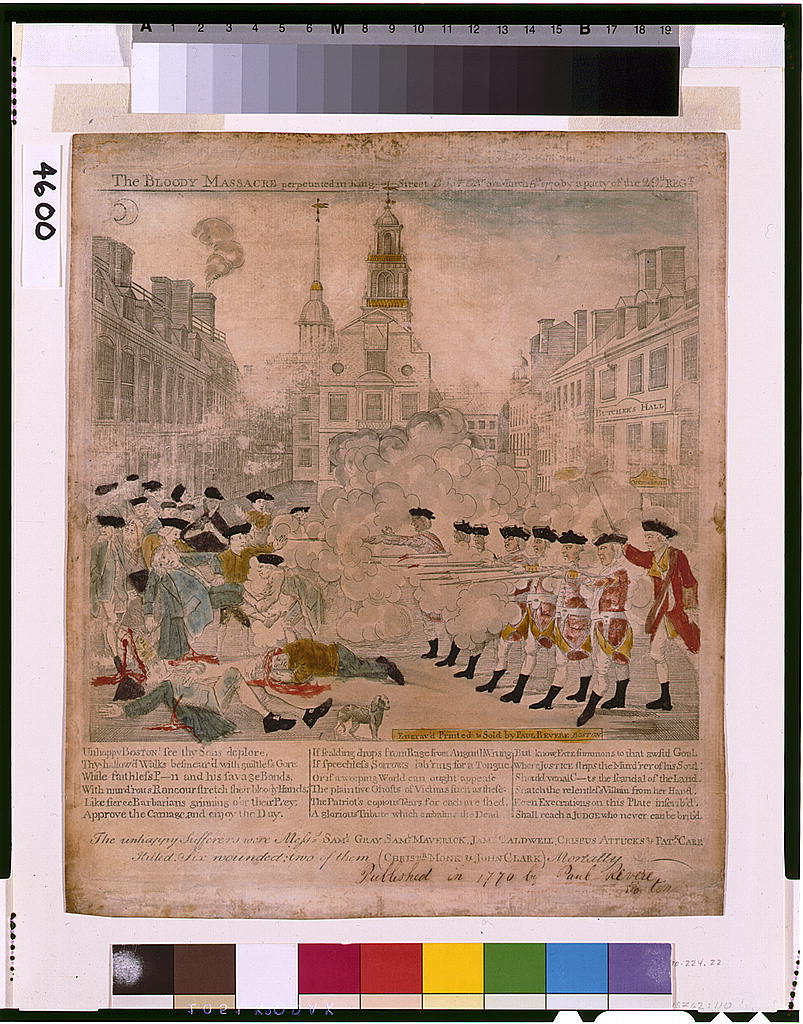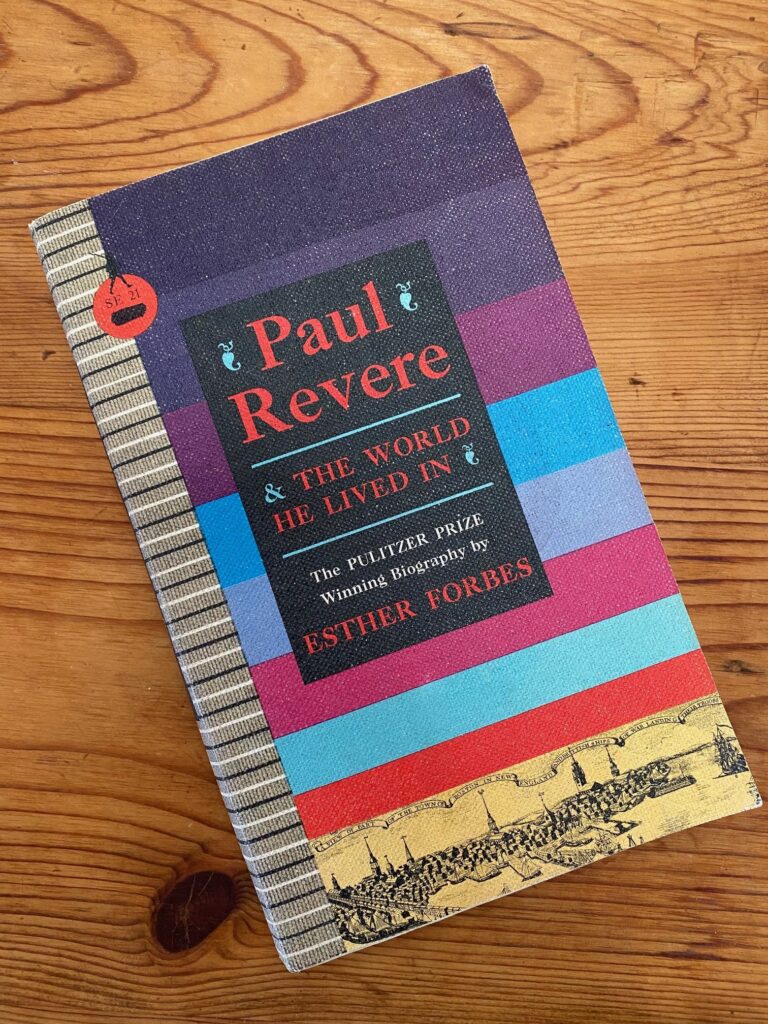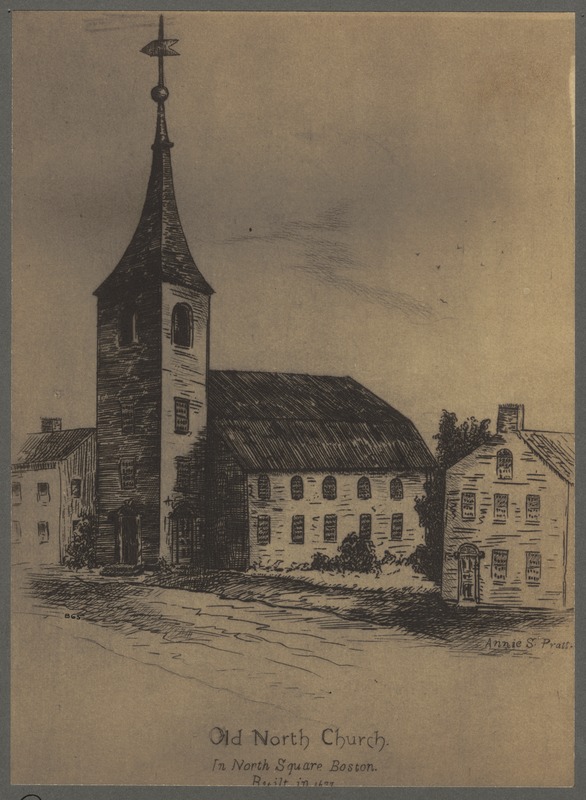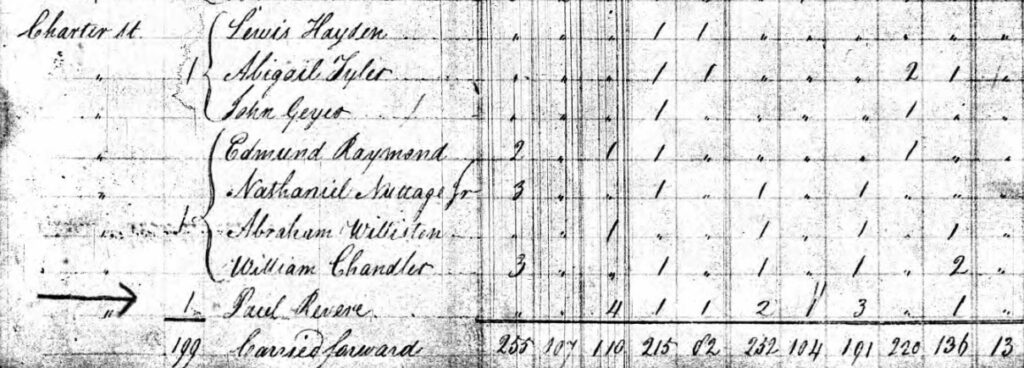It’s been almost 250 years since Paul Revere’s ride and that is the most enduring image we have of Revere the patriot: lanterns and a wild horseback ride shouting “The British are coming!”
Listen, my children, and you shall hear
Of the midnight ride of Paul Revere,
On the eighteenth of April, in Seventy-Five:
Hardly a man is now alive
Who remembers that famous day and year.
Revere must have been a recognizable figure around Boston: a silversmith who was wealthy enough to have his portrait painted by John Singleton Copley several years before the revolution began.
Paul Revere Commemorated the Boston Massacre
I stumbled upon Revere when transcribing records for the DAR a couple of years ago as part of the Patriot Records Project: he was lending money to the revolutionary cause. I wondered how a noted citizen participated in the revolution and if he “flew under the radar” of the British.

There were no news crews or photographs back in time of the Boston Massacre (March 5, 1770), so three weeks afterwards Revere made a engraving of the event (above) which has become an iconic image of the British redcoats firing on unarmed civilians and likely fanned the flames of revolution in the colonies.This wasn’t some secret revolutionary propaganda– he signed his work and sold it!
On a whim I searched for Revere in early newspapers and found that he was mentioned in a colonial newspaper just a year after what we would call the Boston Massacre and still years before the Revolution began at Concord. If this account is true, and that Revere created a public display to remind people of the shooting of colonists by the English, and on display in one of the largest cities in colonies, then I have new respect for the man as a fearless bad ass. Not only was he rebelling against the King, but in public, in front of his own home, and everyone knew it was him!
Tuesday last being the Anniversary of the melancholy 5th of March, 1770 when Mess. Gray, Maverick, Caldwell, Carr, and Attucks, were killed by a Party of Soldiers in King Street, the Bells of the several congregational Meeting Houses were tolled from twelve o’Clock at Noon till one. In the Evening there was a very striking Exhibition at the House of Mr. Paul Revere, fronting the Old North Square, so called. At one of the Chamber Windows was the Appearance of the Ghost of Christopher Sneider, with one of his Fingers in the Wound, endeavoring to stop the Blood issuing therefrom; near him his Friends weeping; at a small Distance a monumental Pyramid, with his Name on the Top, and Names of those killed on the 5th of March round the Base. Underneath, the following Lines,
Sneider’s pale Ghost fresh bleeding stands,
And Vengance for his Death demands.
In the next Window were represented the Soldiers drawn up, firing on the People assembled before them; the dead on the Ground; and wounded falling, with the Blood running in Streams from their Wounds; over which was the Blood running in Streams from their Woods; over which as written FOUL PLAY. In the third Window was the Figure of a Woman representing AMERICA, sitting on the Stump of a Tree, with a Staff in her Hand, and the Cap of Liberty on the Top thereof, one Foot on the Head of a Grenadier lying prostrate, her Finger pointing to the Tragedy.
The Whole was so well executed that the Spectators, which announced to some Thousands, were struck with solemn Silence, and their Countenances covered with a melancholy Gloom. At nine o’Clock the Bells tolled a doleful Peal, until ten; when the Exhibition was withdrawn, and the People all retired to their respective Habitations.
~The Virginia Gazette, 4 April 1771
One of the best sources for information on Revere is Paul Revere & the World He Lived In by Esther Forbes. It won the Pulitzer Prize. You may be more family with Forbes’ fictional work Johnny Tremain. The account given in her book is from the Boston Gazette and it mirrors the report in the Virginia Gazette (thus the report in the Virginia newspaper was taken from the Boston newspaper?). She makes an interesting connection between two pivotal stories in Revere’s life: the effigies hung in the old North Square and later the lamps hung in the old North Church.

Paul Revere’s Ride

Revere’s name made it into the British press in connection to events. Reports of the April skirmish filled all of page 2 of The Public Advertiser (25% of the newspaper!). The stories were introduced with “We have received the following particulars of the Action that lately happened at Boston between the King’s Troops and the Inhabitants of the Massachusetts Bay…”
On Tuesday Night the 18th Inst. as secretly as possible, General Gage draughted out about 1000 or 1200 of his best Troops, which he embarked on a Transport, and landed that Night at Cambridge.–Wednesday Morning, by Daybreak, they marched up to Lexington, where before Breakfast, as usual, about 30 of the Inhabitants were practising the manual Exercise. –Upon these, without the least Provocation, they fired about 15 Minutes, killed six Men, and wounded several, without a single Shot from our Men, who retreated as fast as possible. –Hence they proceeded to Concord; on the Road thither, they fired at, and killed a Man on Horseback, –went to the House where Mr. Hancock lodged, who, with Mr. Samuel Adams, luckily got out of their Way, by the Means of a secret and speedy Intelligence.–The House was searched for them, but when they could not be found, the inhuman Soldiery killed the Woman of the house and all the Children, and set Fire to the House. Mr. Paul Revere was missing when the Express came away. In their Way to Concord, the Regulars fired at and killed Hogs, Geese, Cattle, and every Thing that came in their Way, and burn several House.
~ The Public Advertiser (London) 13 June 1775
It’s interesting that the account published in England contains words slanted toward the Colonists’ cause. Did you catch the part where the writer told of British soldiers killing women and children in their home?
Several accounts I read of Revere’s ride stated that he was stopped by the British and didn’t finish the ridge to give his “The British are coming!” warning. The accounts also state he laid low outside of Boston after the skirmishes in Concord and Lexington. Well, that piqued my interest– what happened that got Revere released from the British to go into hiding
I found the answer in Revere’s own words. He made a deposition after the Revolution. A transcript of his statement is available Massachusetts Historical Society website (see transcription). His detention must have been terrifying:
Major Mitchel, of the 5th Regiment, Clapped his pistol to my head, called me by name, & told me he was going to ask me some questions, & if I did not give him true answers, he would blow my brains out.
He was handed off to a sergeant with orders, “if I attempted to run, or any body insulted them, to blow my brains out.” The Major determined that the sergeant’s horse was tired and he had Revere dismount and give his horse to the sergeant. Once horseless, the British officers departed and left Revere on his own in Concord. Revere then made his way across a field to Mr. Clark’s house where the patriots John Hancock and Samuel Adams were sequestered.
If you haven’t found Ben Franklin’s World podcast it’s worth seeking out their episode on Paul Revere. https://www.benfranklinsworld.com/episode-271-bfw-team-favorites-paul-reveres-ride-through-history/. It’s an interesting examination of why Revere was so important to our view of colonial American and why he’s remembered today. I thought it was interesting as I’ve been thinking about what was known of his activities by the British before and after the Revolution.
A portion of the podcast ponders the 1768 portrait of Revere by Copley. The portrait has been described Revere’s involvement revolutionary events, such as holding a teapot symbolized the fight against the tea tax–however, the tea tax was imposed until 1773. Copley painted prominent citizens, so why was he painting Revere? I think a better question would be to ask what Revere was already up to in 1768. He was 33 years old in that year. I suspect he was already unhappy with the British and deep into the anti-British movement. A timeline on Wikipedia sites several events in 1768 that focused on Boston and were precursors to the Revolution.
Perhaps Revere’s position can be deduced through the artist behind his portrait. John Singleton Copley was born in the American colonies. He painted the upper class of merchants in Boston– Samuel Adams, John Hancock, … and Revere. Copley left America in 1774 (the year before Revere’s midnight ride). He never returned, staying in England to paint aristocrats, military men, and other members of the upper classes. Maybe he went to England and painted the subjects who could afford his craft. Copley’s alliances with wealthy patrons hints that Revere may have had social alliances in Boston, perhaps these alliances joined him with the likes of Adams and Hancock in revolutionary activities, and they may have been alliances in a social class that also protected him from British scrutiny.
Paul Revere Founding Father?
So let me throw out a question to readers: was Paul Revere a founding father? He’s certainly embedded in American memory as an important player in the revolution, however my answer would have to be a firm “no.” He was an instigator, an activist, a seditionary, a guerilla (Boston Tea Party and even his ride I believe give him the title of guerilla warrior). Definitely a “patriot” by DAR standards. I think of founding fathers as the men and women who created the structure of the new country. Funny though, I can’t picture us getting to that point of creating a new country with the the likes of Revere and the other instigators who fired up the citizenry to the point of rebellion.
1810: Paul Revere On The Census
Revere survived the Revolution and lived on to 1818. He was counted in Boston, Suffolk County, Massachusetts on the 1810 census.



